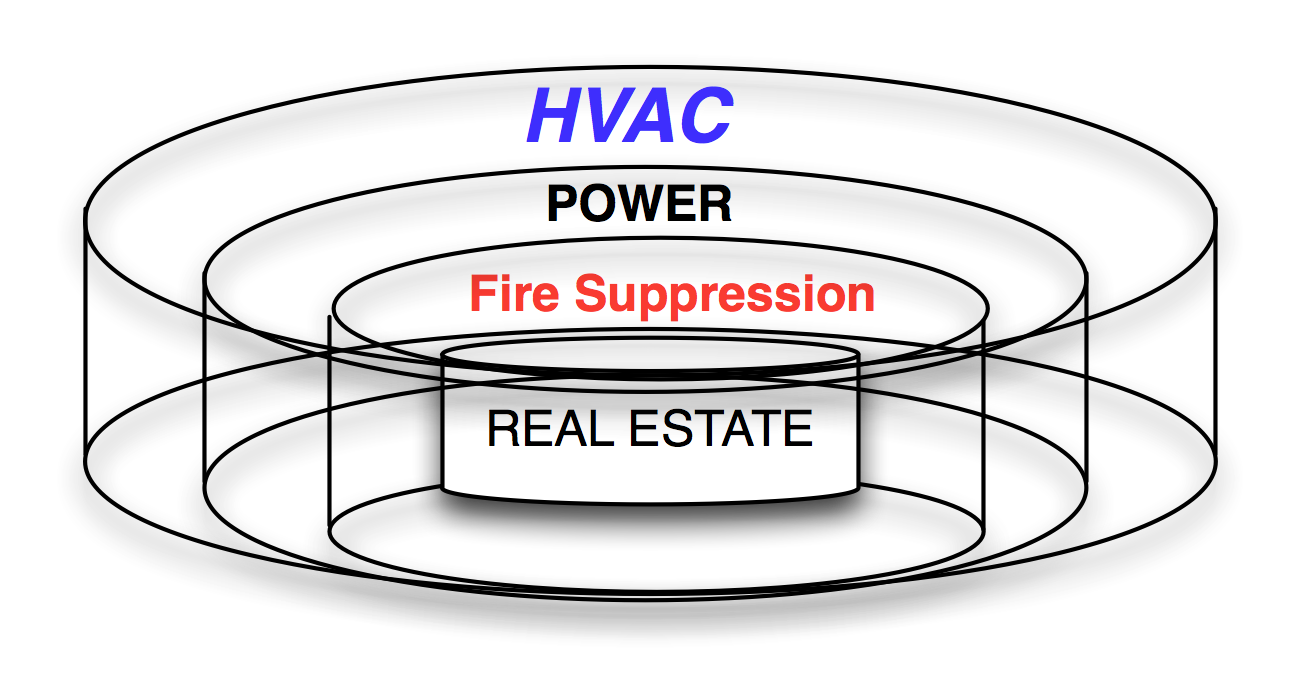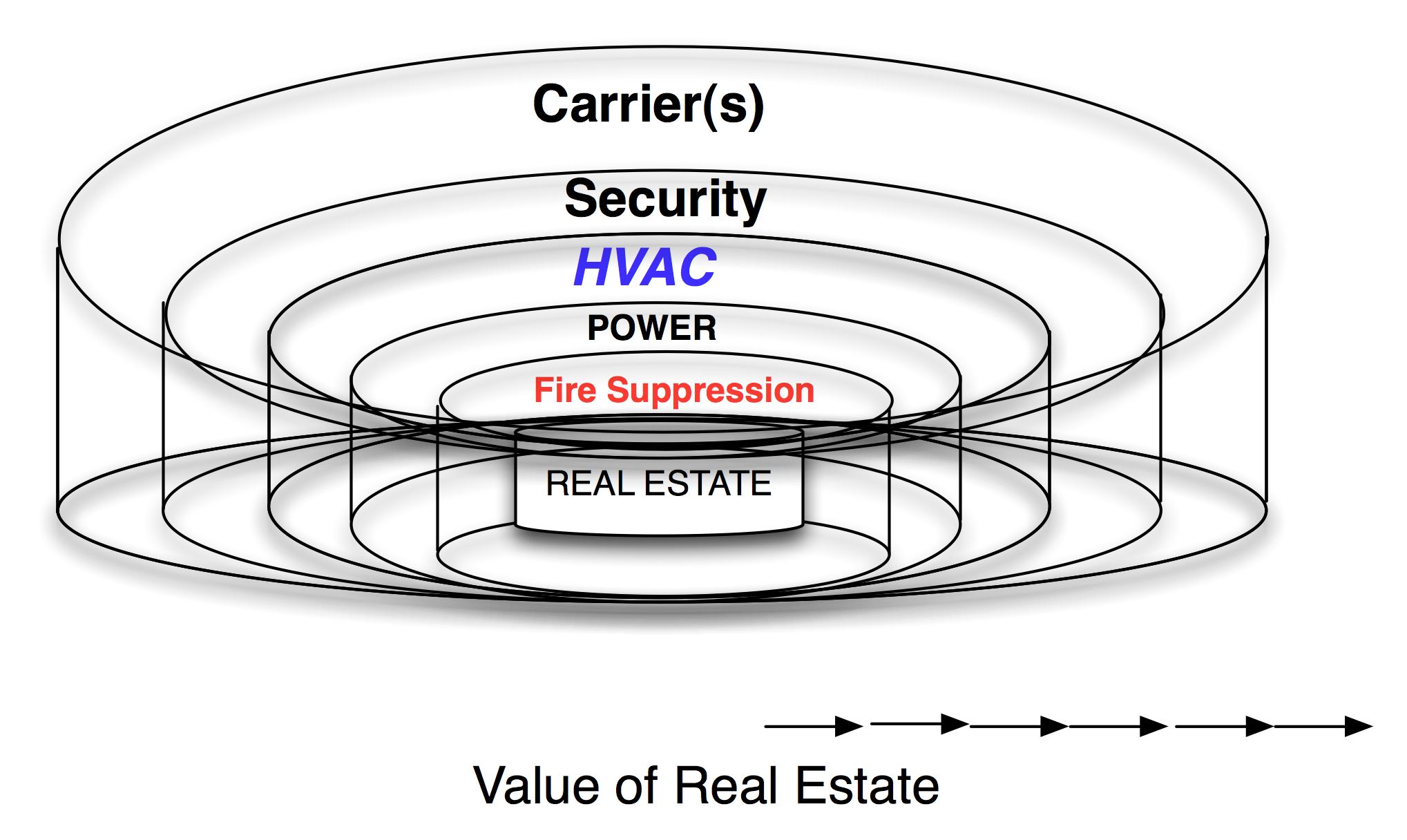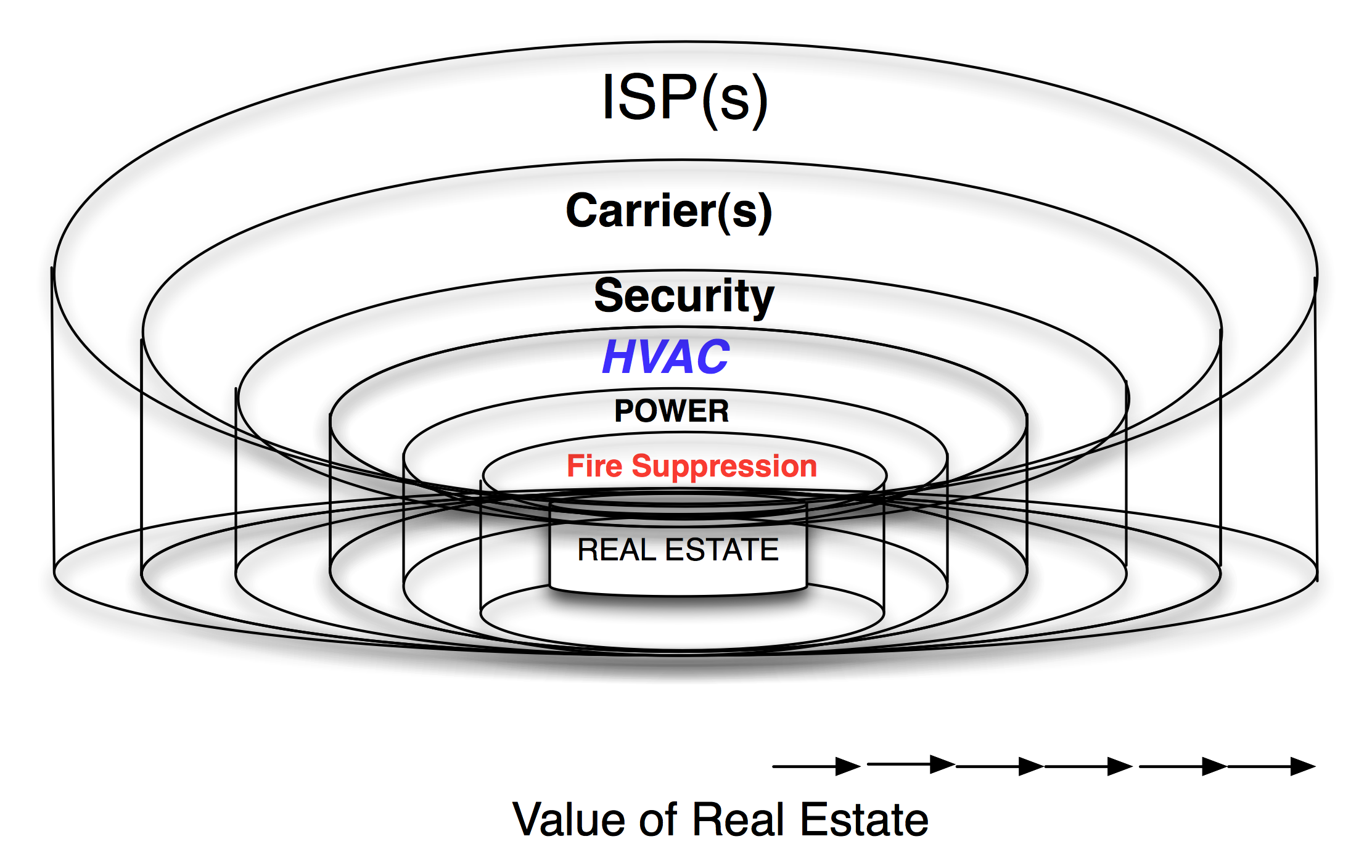What is the value of a colocation center? As more real estate folks try and break into the colocation business in search of higher returns for their square feet, there is a greater need for understanding of the Internet Ecosystem. Success in the colocation arena requires a higher level of understanding than just square feet.
last updated August 2010
Here is the typical chalk board model talk I give to my investor clients.
You can express the value creation in the Internet Data Center space as a set of concentric value enhancing rings built around real estate.
At the core you have the real estate, which is, as the expression goes, all about location. For real estate that is destined to be a colocation center, proximity to fiber is critical, as this is what the tenants will ride in on. If the colocation center is far from fiber, then the cost of building in is higher. The most valuable colocation centers are located at fiber nexus points. Real estate and proximity to fiber is so important that we are starting to believe that the value equation in Modeling the Value of an Internet Exchange needs to take into account the cost of building into the IX. So, an IX that is expensive to get to will be inherently less valuable to the peering population than a similar IX that is relatively inexpensive to get into. Why? Because the cost of peering will be less there and it will be easier to attract more peers in. But we digress - back to the real estate core of the model.

The developer at some point will install a fire suppression system in the real estate to make protect it and whatever goes inside. This becomes a more valuable piece of real estate as a result.

When the developer builds out the real estate to include reliable power, the real estate becomes more valuable. Now it isn't just square feet with fire suppression and location benefits; it also has conditioned power and can provide power during brown and black outs. Build around that a Heating, Venting and Air Conditioning (HVAC) System and you have a facility that not only has the location characteristics and conditioned power, but is also fully conditioned space suitable for reliably hosting telecom equipment. This is more valuable still. For some customers in fact, the availability and price of power are the key selection criteria between colocation companies.

A security ring of services around this conditioned space makes it a secure conditioned space with reliable power in a location with certain characteristics. If this is a single tenant building then perhaps the security ring is a simple single secured exterior and a sufficiently secured employee access point. For multi-tenant data centers however, as all colocation spaces are by definition, the security ring needs things like customer employee authentication and escorts, multi-tenant logging systems with biometrics, camera systems archived for months, etc.
Without Network, a Data Center is an island.
Armed with conditioned space, the colocation space needs carriers - those that can provide transport in to the colocation space for the tenants. These are the folks that bring in layer 1 and layer 2 connectivity - circuits for the tenants to use to get bits into and out of this point of presence. Some data centers are owned by the carriers themselves and rarely have alternative providers selling transport to their customers. Carrier neutral data centers however support multiple carriers selling transport to the customer base, making the well-connected colocation center inherently more valuable than one with zero or only one carrier selling services.

Around the carrier ring is the ISP ring. The ISPs come into the building to establish a point of present, to peer with one another, or to participate (buy/sell) in the marketplace for transit services. Here again, an ISP-owned data center is unlikely to have competitors in their building selling transit to their customers, but a colocation center will tend to have a variety of ISPs forming the open market place for transit services. Some in the community estimate prices for transit to be 30% less in well populated colocation centers than outside the colocation center. The more ISPs the better as far as the colocation provider is concerned as the open and robust marketplace for transit and peering are the key value propositions that will bring additional customers in.

Finally, hosting companies, portals, CDNs, content providers, etc. tend to prefer a richly networked ISP colocation center with an open marketplace of ISP services. This provides the required flexibility, robustness and ever decreasing transit prices that are reasons that large scale content providers build into colocation centers in the first place.
What differentiates colocation centers from the real estate players?
The key differentiator between providers of real estate and providers of colocation space is the managed ecosystem. Colocation is more than a real estate play - successful colocation providers understand their customers ecosystem, and build the right mix of players based on how customers interact with and derive value from each other.
Index of other white papers on peering
WIlliam B. Norton is the author of The Internet Peering Playbook: Connecting to the Core of the Internet, a highly sought after public speaker, and an international recognized expert on Internet Peering. He is currently employed as the Chief Strategy Officer and VP of Business Development for IIX, a peering solutions provider. He also maintains his position as Executive Director for DrPeering.net, a leading Internet Peering portal. With over twenty years of experience in the Internet operations arena, Mr. Norton focuses his attention on sharing his knowledge with the broader community in the form of presentations, Internet white papers, and most recently, in book form.
From 1998-2008, Mr. Norton’s title was Co-Founder and Chief Technical Liaison for Equinix, a global Internet data center and colocation provider. From startup to IPO and until 2008 when the market cap for Equinix was $3.6B, Mr. Norton spent 90% of his time working closely with the peering coordinator community. As an established thought leader, his focus was on building a critical mass of carriers, ISPs and content providers. At the same time, he documented the core values that Internet Peering provides, specifically, the Peering Break-Even Point and Estimating the Value of an Internet Exchange.
To this end, he created the white paper process, identifying interesting and important Internet Peering operations topics, and documenting what he learned from the peering community. He published and presented his research white papers in over 100 international operations and research forums. These activities helped establish the relationships necessary to attract the set of Tier 1 ISPs, Tier 2 ISPs, Cable Companies, and Content Providers necessary for a healthy Internet Exchange Point ecosystem.
Mr. Norton developed the first business plan for the North American Network Operator's Group (NANOG), the Operations forum for the North American Internet. He was chair of NANOG from May 1995 to June 1998 and was elected to the first NANOG Steering Committee post-NANOG revolution.
William B. Norton received his Computer Science degree from State University of New York Potsdam in 1986 and his MBA from the Michigan Business School in 1998.
Read his monthly newsletter: http://Ask.DrPeering.net or e-mail: wbn (at) TheCoreOfTheInter (dot) net
Click here for Industry Leadership and a reference list of public speaking engagements and here for a complete list of authored documents
The Peering White Papers are based on conversations with hundreds of Peering Coordinators and have gone through a validation process involving walking through the papers with hundreds of Peering Coordinators in public and private sessions.
While the price points cited in these papers are volatile and therefore out-of-date almost immediately, the definitions, the concepts and the logic remains valid.
If you have questions or comments, or would like a walk through any of the paper, please feel free to send email to consultants at DrPeering dot net
Please provide us with feedback on this white paper. Did you find it helpful? Were there errors or suggestions? Please tell us what you think using the form below.
Contact us by calling +1.650-614-5135 or sending e-mail to info (at) DrPeering.net